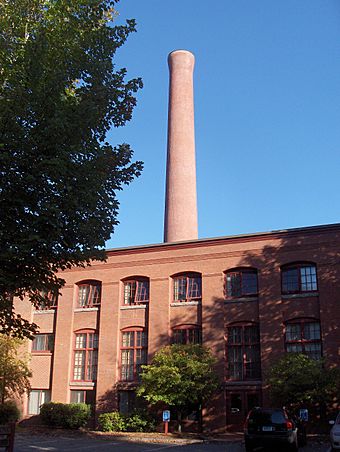Warrenton Woolen Mill facts for kids
Quick facts for kids |
|
|
Warrenton Woolen Mill
|
|
 |
|
| Location | 839 Main St., Torrington, Connecticut |
|---|---|
| Area | 6.7 acres (2.7 ha) |
| Built | 1908 |
| Architect | Main, Charles T. |
| NRHP reference No. | 87000115 |
| Added to NRHP | February 12, 1987 |
The Warrenton Woolen Mill is a historic factory building in Torrington, Connecticut. It is located at 839 Main Street. This mill started making fabric in 1844. It was very important to the local area's jobs and money until it closed in 1984. The buildings you see today were mostly built in the early 1900s. In 1987, it was added to the National Register of Historic Places. This means it is a special place recognized for its history. Now, the old mill has been changed into homes called the Warrenton Mill Condominiums.
What the Mill Looks Like
The old Warrenton Woolen Mill is north of downtown Torrington. It sits on the west side of the East Branch Naugatuck River. You can reach it from Main Street by crossing the river.
The mill has eight buildings in total. Most of these buildings were built around 1908. There are two main brick buildings. One is two stories tall, and the other is three stories tall. Other smaller buildings connect them. These two main buildings are very long, over 250 feet each. They are built in a simple, classic factory style. Part of the roof on the weaving area looks like saw teeth. This design lets in a lot of natural light.
A Look Back at the Mill's History
People first started making textiles, or fabrics, at this spot in 1844. Important families, like the Wolcotts, helped invest in the mill. The buildings that stand today were built in 1908. A famous factory designer named Charles T. Main created their plans. These are the only buildings he designed in Connecticut that we know of.
The mill kept making fabric until 1984. For many years, especially after the late 1800s, the company made special heavy fabrics. These fabrics were used for uniforms for police and military groups. After it closed, the old mill found a new purpose. It was turned into modern apartments.



